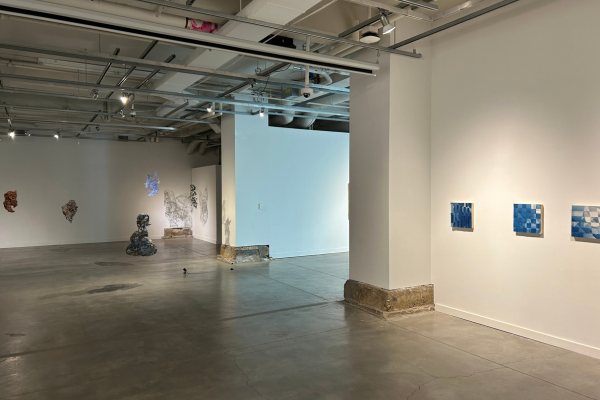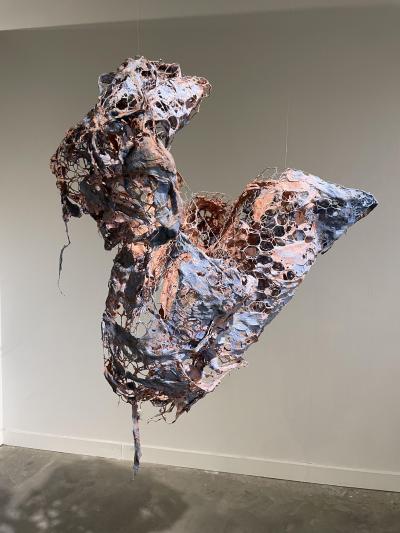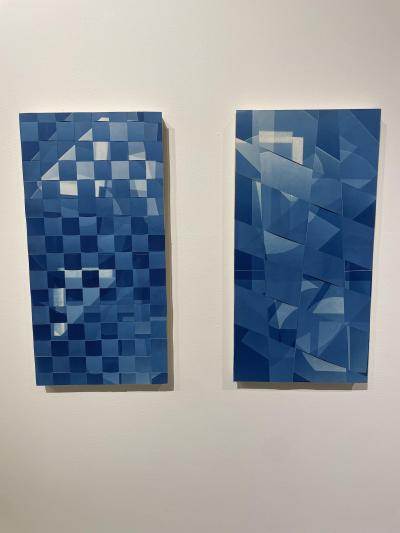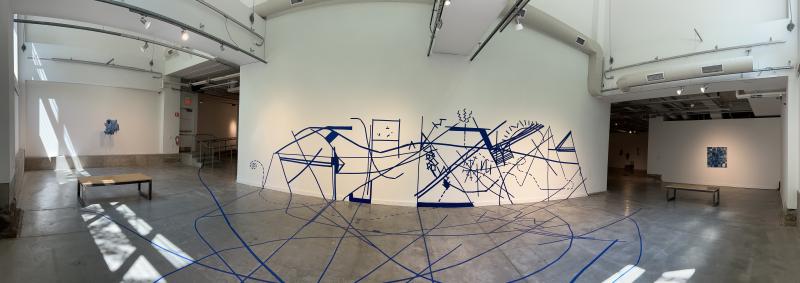Conduit: An Interview with Alissa Ohashi and Janelle Bonfour-Mikes

Conduit was on view at Urban Arts Space from July 20–29, 2023. Here, UAS student intern Toby Mars interviews Alissa Ohashi and Janelle Bonfour-Mikes, the two artists who collaborated to create this installation and performance. Watch the video below for a visual tour of the exhibition and snapshots of the live performance!
1. Where did the name for the show, Conduit, come from? How do you feel it represents the energy of the show?
Ohashi: Initially, we were thinking about calling the show Pathways, as we were musing, existentially, about life and thinking about connections made and paths crossed.
I think about quantum entanglement as well as the phrase, “the All is Mind; the Universe is Mental.” I think about the interconnectivity of everything and how we, humans, can coherently tap into this interconnected field of energy and channel the same vibrational frequency with which we’re matched at any given moment. Conduit, for me, seems to connect these ideas with the art that we create.
Bonfour-Mikes: I honestly don’t even quite remember where it came from. We had been brainstorming title ideas and talking about what/where we are in the universe and the purpose of life, and I think it just happened upon us. I think it perfectly sums up how we view ourselves as artists. We are the channel in which these works came into existence.
2. How do the two of you know each other? How do you feel your relationship influences the work?
Ohashi: Janelle and I met in grad school at CCAD in 2017. Our relationship influences the work in a vulnerable and authentic way, because we trust and respect each other—both as human beings and artists.
Bonfour-Mikes: We met in grad school; we were in the same cohort. In my first project, I was experimenting with storytelling and my specific history with sexual assault. She invited me to have brunch, and that is where our friendship began. In that first semester, she was also photographing different women with their stories and identities, and I'm a former dancer who loves having her picture taken.
I don’t know that our relationship really influences my work. I go to her for feedback and either take it or leave it, which I guess influences my work to some degree. I know that she will always be honest with me and doesn’t judge me based on the caliber of my projects, nor does she take it personally when I don’t apply her feedback to my work. I truly cherish the trust and honesty that we’ve built.

3. Each of you work with different materials and themes that are both personal and expansive. How do you feel the crafts interact with one another?
Ohashi: Speaking to the processes that we use within each of our chosen mediums, we both utilize weaving—Janelle with paper and I with twine and wire. Additionally, without knowledge of the other’s decision, we both decided to hang in a salon-style manner—Janelle’s secured on the walls and mine floating through space.
Contrasting the similarity with weaving and installation, Janelle’s work is two-dimensional and geometric, and mine is 3-D and organic. Hers, at first, seems more concrete, mine more fluid, but as you look further, you’re able to observe a myriad of dualities that oscillate on the full spectrum and exist within each body of work.
Bonfour-Mikes: I think the most obvious is our non-choice of using blue. In my cyanotypes they are just blue, and with her work blue was one of the few colors available at the time of creation. We both kind of just went with it. Then, there’s the installation; we’re both playing with height and how the viewer must navigate through the space either with their whole bodies or just with their eyes. Once I saw the show completely installed, I realized that her sculptures feel like 3D versions of my weavings. In a way, we are both exploring similar ideas but using different words.
4. The use of the color blue in each of your works serves to visually link the different sections of the show. How does color function in your artistic practices? What other elements or principles of art do you find yourself focusing on when creating work?
Ohashi: Color isn’t generally at the forefront of my mind when I make work, although I do love color. I tend to get fixated on shape, texture, and composition. I like to use numerous fragmented pieces and organize them in a way that supports the idea “the whole is greater than the sum of its parts.” My work, overall, seems to collect moments on a personal level and tell a story that is universal.
Bonfour-Mikes: I don’t often think of color—cyanotype is just blue. I’ve experimented with toning, but nothing has been as striking as blue. Once I realized I didn’t want to change the color blue, I decided to become obsessed with it. Now, I’m always thinking in blue. There’s something so tranquil and melancholic about blue—and also completely common but oh-so rare.
This body of work was a huge departure from what I’ve focused on previously. I’m usually very interested in storytelling and referencing (somewhat obscure and often symbolically) personal trauma and other autobiographical events and feelings. I often make work with the intention of the viewer having a visceral reaction, really feeling it in their bodies.

5. What music do you listen to when you are brainstorming/working/making?
Ohashi: I listen to a variety of music and podcasts while I’m making work. Some of my go-tos are Nina Simone, Erykah Badu, Lauryn Hill, East Forest, Alan Watts Chillstep, jazz, or binaural beats. For podcasts, I listen to Ram Dass Here and Now, On Being, The Great Women Artists, and This Jungian Life.
Bonfour-Mikes: One of the first things I do once I get an idea is to make a playlist. Here is the link to the playlist for this body of work. So, it definitely varies by project.
My go-tos:
- creative slump - Black Sabbath, Pauline Oliveros, Anne Lockwood get shit done - Tropical Fuck Storm and Thee Oh Sees
- researching - Throbbing Gristle, SZA, Fiona Apple
- post-performance melancholy - Screaming Females
6. What artists inspire you, both in terms of this show and in general?
Ohashi: Artists that inspire me are Eva Hesse, Carrie Mae Weems, Zanele Muholi, Lorna Simpson, Ruth Asawa, Hilma af klint, Phyllida Barlow . . . the list goes on.
Bonfour-Mikes: For this show, I was looking at Barbara Kasen, Lenore Tawney, John Cage, and Mercy Cunningham Honestly, I didn’t look outward for a lot of inspiration in this work. In general, I spend a lot of time with work by Yoko Ono, Tracey Emin, Ana Mendieta, and Faye Driscoll.
7. What message or ideas do you want people to take from the show?
Ohashi: I would like people to consider how everything in existence is connected. I would like people to pause, feel, and embody presence.
Bonfour-Mikes: I really want people to walk away with a sense of stillness in their bodies and a new appreciation for shapes in the clouds. I want the audience to know that not everything has to have some grand meaning and we get to choose what does or doesn’t have meaning in our lives.
https://www.janellebonfour-mikes.net/

